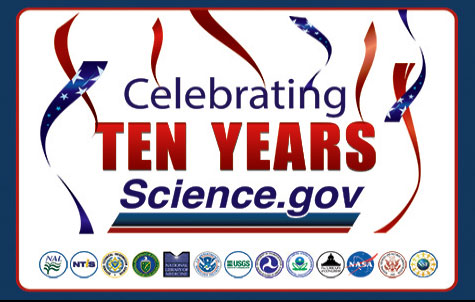 What is the gas mileage of your car? How much of your state is water covered? Where can you download software that will give atomic precision to your computer’s clock? These and many other questions can and have been answered by Science.gov (http://science.gov) – the Federal government’s “one stop” real-time science data website, which is now celebrating its 10th anniversary.
What is the gas mileage of your car? How much of your state is water covered? Where can you download software that will give atomic precision to your computer’s clock? These and many other questions can and have been answered by Science.gov (http://science.gov) – the Federal government’s “one stop” real-time science data website, which is now celebrating its 10th anniversary.
Science.gov was launched in December 2002 and has broken new ground in interagency collaboration. Senior information managers representing 13 Federal agencies forged a consensus on how national science organizations could improve public access to the nation’s rich and diverse scientific research information and partnered to create the Science.gov Web portal.
“Over the past 10 years Science.gov has grown in content, capability, features and functionality,” said Tina Gheen of the Library of Congress and chair of the Science.gov Alliance (http://www.science.gov/participatingagencies.html). “As a result, we have seen significant user growth. We are very proud of this offering of sound science to the public, and we hope to continue providing this free service for years to come.”
There are now more than 200 million pages in Science.gov, and the annual page views top 34 million, a 45-fold increase from the earliest days. The founding idea was to provide a comprehensive gateway to federal science information for those who might not know exactly where to find it. The interagency effort would raise scientific and technical literacy, serve as a foundation for future discoveries, and foster greater understanding of the public’s return on investment from the government’s science and technology efforts.
“From its inception, Science.gov has been a model of collaboration, transparency and open government,” said Alliance co-chair Annie Simpson of the U.S. Geological Survey. “Back in 2002, Science.gov was touted as a wonderful ‘potluck picnic’ of science agencies pooling their efforts so citizens could find the science information they need. Well, today we are still pooling our resources because the sum is more useful to the American public than what any individual agency can do.”
The technology has changed and improved, but the goals remain the same; Science.gov strives to grow and evolve to serve users even better. In addition to recent enhancements, in June Science.gov Mobile (http://m.science.gov/scigovmobile/) made it onto two Top Ten Federal government applications lists. A Spanish version (http://ciencia.science.gov/) of the website was launched in October along with video and image search and other improvements.
For interesting facts from the Science.gov Alliance members, see: www.science.gov/coolstuff.html
###
About the Science.gov Alliance: The interagency Science.gov Alliance – which governs Science.gov – includes the Departments of Agriculture, Commerce, Defense, Energy, Health and Human Services, Homeland Security, the Interior, and Transportation; the Environmental Protection Agency, the Library of Congress, the National Aeronautics and Space Administration, the National Archives and Records Administration, and the National Science Foundation. These agencies represent 97 percent of the federal R&D budget.
The Science.gov website is hosted by the U.S. Department of Energy Office of Scientific and Technical Information (OSTI), within the Office of Science.
Science.gov, your gateway to U.S. federal science, is supported by CENDI (http://www.cendi.gov), an interagency working group of senior scientific and technical information managers.
In summary, here are the links with the above information and related topics:
